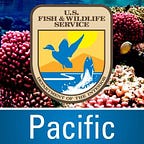Another Milestone at Palmyra Atoll - One Million Coconut Palms Removed
By: Ivan Vicente, Public Affairs Officer, U.S. Fish and Wildlife Service
Located in the Northern Line Islands, approximately 1,000 miles south of Honolulu, Palmyra Atoll — a USFWS National Wildlife Refuge, TNC Preserve and Mission Blue Hope Spot — is an important center of biodiversity and species abundance in the Central Pacific region.
Prior to Palmyra Atoll’s establishment as a National Wildlife Refuge, a number of invasive species were introduced to the atoll. These introductions have had negative impacts on the native ecosystems affecting many of its species.
The Refuge was established in 2001 to protect and preserve the natural character of the resources associated with the lands and waters of Palmyra Atoll. It is the only moist tropical atoll ecosystem in the Central Pacific that is entirely protected under a federal conservation mandate, and the only atoll ecosystem in this region that is not experiencing wholesale exploitation of both marine and terrestrial natural resources by burgeoning human populations.
In 2011, Palmyra Atoll celebrated a tremendous conservation success with the eradication of rats from the atoll — a partnership effort that started back in 2004. Successful removal of invasive black rats secured habitat for native seabirds, crabs, and plant populations.
Almost immediately following the successful removal of rats in 2011, invasive coconut palms sprang up across the atoll. Without rats to eat them, rapidly growing coconut palms formed dense stands, outcompeting native trees. By 2016, an estimated 29,000 adult palms and two million seedlings covered the atoll’s islands.
To reverse the palm’s dominance and restore Palmyra’s native rainforest, the three conservation partners initiated the Palmyra Atoll Rainforest and Reef Resilience Project (PARP) in April 2019.
In areas where rapidly growing coconut palms have outcompeted native tree species, dense stands have formed resulting in lower diversity of birds, land crabs, and even insect species, compared to the native rainforest.
The relentless conservation efforts at Palmyra Atoll continue to shine with a new milestone — surpassing one million palms removed. This tremendous feat is paving the way for natural recovery and planting of native vegetation.
Since 2019, twenty five full-time volunteers have dedicated months of their lives to living at Palmyra investing over 4,700 person hours of coconut control work, making significant progress even amid the pandemic, eliminating over one million palms. Much remains to be done before declaring full coconut control success, but this level of progress is inspiring.
A sign of natural recruitment took place in late 2020, when the native Pisonia grandis, a naturally dominant tree species, underwent a masting event — dispersing seeds across the atoll in numbers not seen in almost a decade. To supplement the natural recovery, field teams are hand-planting native tree species where coconut palms have been removed.
Vegetation recovery is a critical PARP goal because branching native trees provide more suitable habitat for native seabirds. Roosting in the native trees, seabirds’ nutrient-rich guano seeps into the surrounding land and marine environment, feeding phytoplankton which in turn nourish fish and corals. The team is restoring the native tropical rainforest by replacing approximately two million palms with native trees.
Palmyra Atoll serves as a living laboratory for conservation scientists to better understand the cascading benefits of protecting coastal ecosystem, and to study climate resilience of atolls. This rainforest to reef connection is critical since insights gained by studying Palmyra Atoll’s rainforest and reef will have far-reaching benefits for similar island ecosystems around the world.
The U.S. Fish and Wildlife Service works with others to conserve, protect, and enhance fish, wildlife, plants, and their habitats for the continuing benefit of the American people. For more information, connect with us through any of these social media channels at https://www.facebook.com/PacificIslandsFWS, www.flickr.com/photos/usfwspacific/, or www.twitter.com/USFWSPacific.
